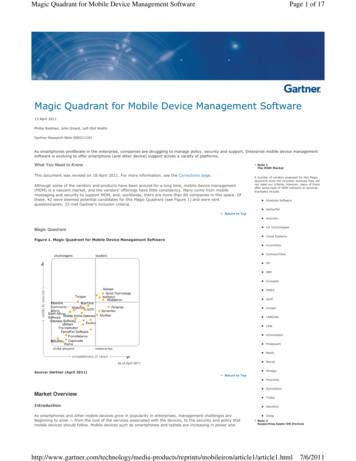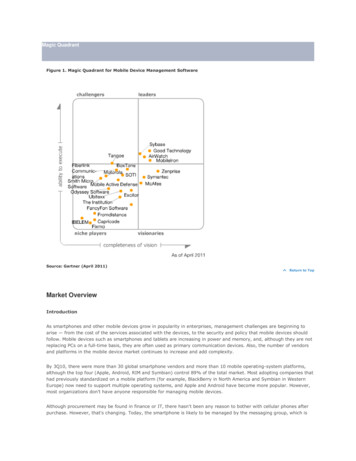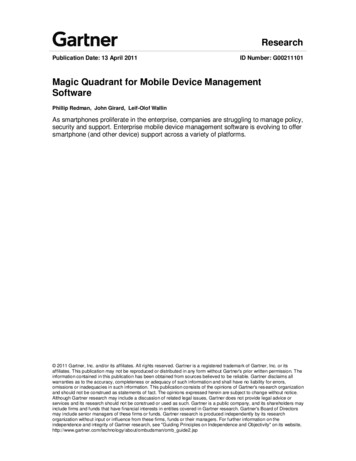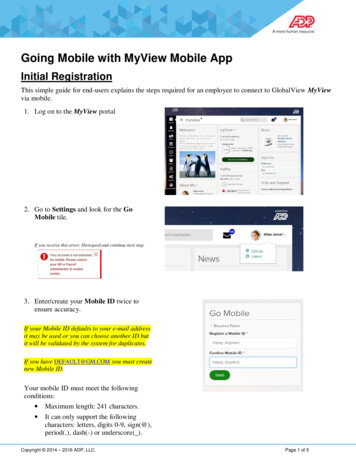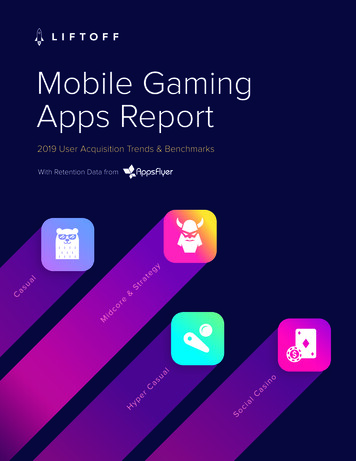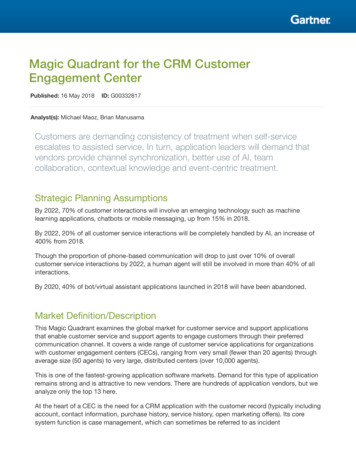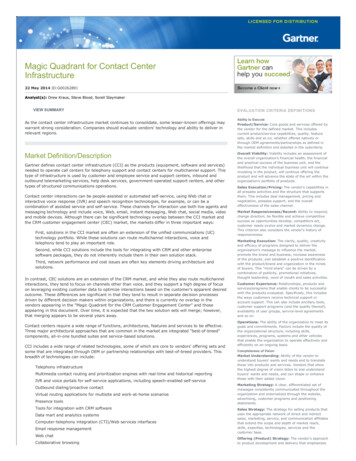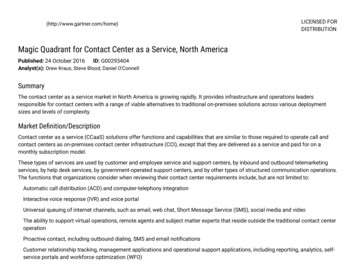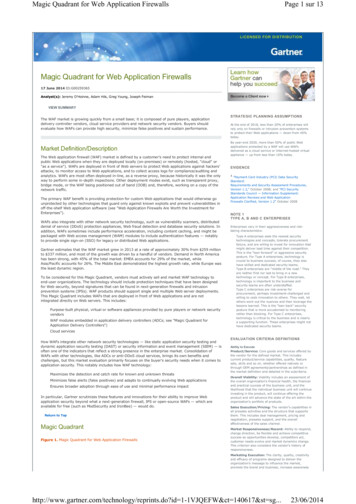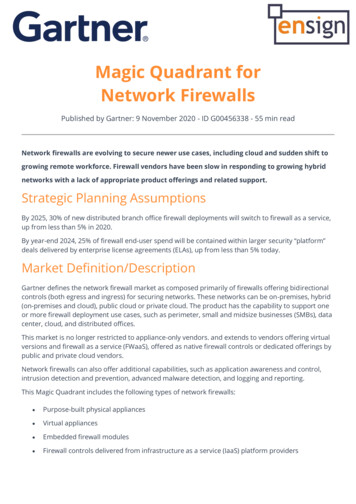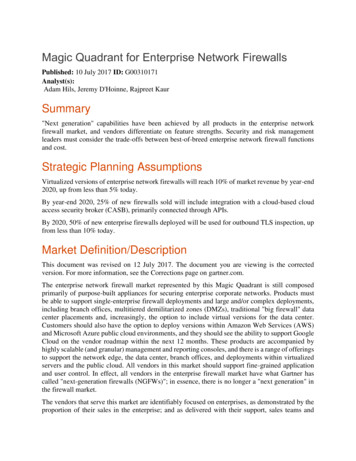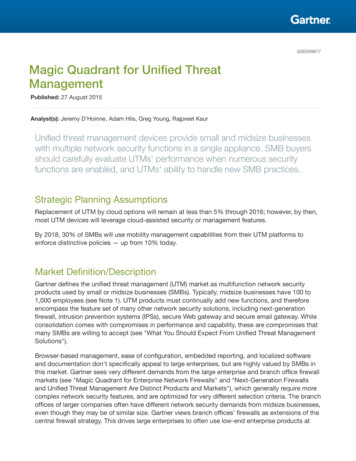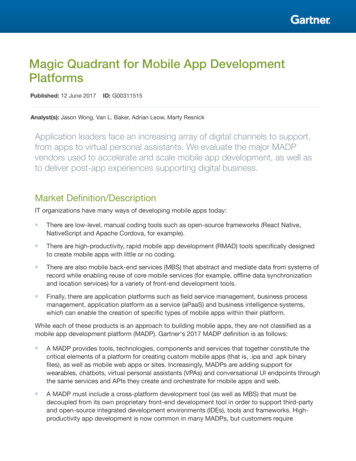
Transcription
Magic Quadrant for Mobile App DevelopmentPlatformsPublished: 12 June 2017ID: G00311515Analyst(s): Jason Wong, Van L. Baker, Adrian Leow, Marty ResnickApplication leaders face an increasing array of digital channels to support,from apps to virtual personal assistants. We evaluate the major MADPvendors used to accelerate and scale mobile app development, as well asto deliver post-app experiences supporting digital business.Market Definition/DescriptionIT organizations have many ways of developing mobile apps today: There are low-level, manual coding tools such as open-source frameworks (React Native,NativeScript and Apache Cordova, for example). There are high-productivity, rapid mobile app development (RMAD) tools specifically designedto create mobile apps with little or no coding. There are also mobile back-end services (MBS) that abstract and mediate data from systems ofrecord while enabling reuse of core mobile services (for example, offline data synchronizationand location services) for a variety of front-end development tools. Finally, there are application platforms such as field service management, business processmanagement, application platform as a service (aPaaS) and business intelligence systems,which can enable the creation of specific types of mobile apps within their platform.While each of these products is an approach to building mobile apps, they are not classified as amobile app development platform (MADP). Gartner's 2017 MADP definition is as follows: A MADP provides tools, technologies, components and services that together constitute thecritical elements of a platform for creating custom mobile apps (that is, .ipa and .apk binaryfiles), as well as mobile web apps or sites. Increasingly, MADPs are adding support forwearables, chatbots, virtual personal assistants (VPAs) and conversational UI endpoints throughthe same services and APIs they create and orchestrate for mobile apps and web. A MADP must include a cross-platform development tool (as well as MBS) that must bedecoupled from its own proprietary front-end development tool in order to support third-partyand open-source integrated development environments (IDEs), tools and frameworks. Highproductivity app development is now common in many MADPs, but customers require
openness and to avoid lock-in with the front-end tooling to be able to support native IDEs andpopular frameworks that may emerge. A MADP must be able to address the requirements of diverse enterprise use cases, includingexternal-facing and internal-facing scenarios, as well as connecting to diverse enterprisesystems that may run on-premises or in the cloud. Because MADPs serve as the cornerstone ofan enterprise mobile strategy, they need to be as broad as possible in addressing both frontend and back-end development needs. A MADP serves to centralize the life cycle activities (such as design, develop, test, distribute,manage and analyze) for a portfolio of mobile apps running on a range of operating systemsand devices. This is critically important for IT organizations to manage the ongoing maintenanceand support of apps, as well as the back-end mobile APIs, to enable proper DevOps practices.The MADP market consists of independent vendors and MADP products that are part of a largervendor's portfolio or solution. Clients can purchase any MADP product as a stand-alone offering,although some MADPs have many optional and related components and most offer "free forevaluation" or open-source tools, which can make up a significant percentage of a vendor's userbase.Over the years, the independent vendors in this space have mostly been acquired by largervendors, which demonstrates the criticality of mobility in many enterprise systems. However, thereare still dozens of independent vendors, as well as vendors transforming their products (such asMBS and RMAD) into MADPs. Some vendors listed in previous years' MADP research have notevolved to meet Gartner's MADP definition for 2017, although they may still be used to createcertain types of apps. Gartner expects the MADP space to continue to evolve rapidly: as wearables,bots and conversational UI channels need to be folded into the omnichannel approach of theseplatforms; and as mobility permeates deeper in other enterprise systems and platforms.Page 2 of 34Gartner, Inc. G00311515
Magic QuadrantFigure 1. Magic Quadrant for Mobile App Development PlatformsSource: Gartner (June 2017)Gartner, Inc. G00311515Page 3 of 34
Vendor Strengths and CautionsAdobeAdobe is in the Niche Players quadrant this year, which is a move from its position in the Leadersquadrant in 2016. During the past year, Adobe has shifted its go-to-market execution away from theMADP space with its Adobe Experience Manager (AEM) Mobile product. In March 2017, Adobeunveiled a new consolidated Adobe Experience Cloud offering of which AEM Mobile is acomponent; yet its long-term MADP product tooling and sales strategy remain unclear at the time ofwriting.Adobe offers a cloud-based MADP that is focused on marketers and enterprises wanting to delivermobile apps that run within its Adobe Experience Cloud. AEM Mobile is a high-productivity hybridapp development tool that incorporates Adobe's PhoneGap technology to enhance the platform viaa wide assortment of libraries and extensions. AEM Mobile is used to create mobile apps that canautomatically identify and deliver assets from Adobe Experience Cloud, with changes beingmanaged by Adobe Campaign, which is also part of the Experience Cloud. Adobe Analyticscomplements the AEM Mobile platform with a deep offering spanning both performance andbehavioral analytics. Overall, Adobe's MADP offering has become more tightly integrated into theAdobe technology stack, thereby making it less appealing as a general-purpose MADP.Adobe has a large customer base on Adobe Experience Cloud, although new licensing for AEMMobile has slowed during the past year as the company focuses on its content platform. Adobe isdeprioritizing technologies to build mobile apps in favor of opening up its content platform to allcustomer interaction channels in order to maintain a connected brand experience. It continues tosupport customers who have made AEM Mobile a key part of their mobile strategy.Note: Adobe declined to participate in the research process for this Magic Quadrant; it identified noreference customers and did not respond to requests for supplementary information. Gartner'sanalysis of Adobe in this Magic Quadrant is therefore based on other credible sources, includingprevious vendor briefings, customer inquiries, Gartner Peer Insights reviews and other publiclyavailable information. Gartner Peer Insights reviews of Adobe's MADP (at the time of writing) point toaverage overall satisfaction.Strengths Vertical strategy: At the time of writing, Adobe's offering targets marketing professionals witheasy-to-use tools that facilitate the management of marketing content and campaigns and weband mobile apps. Although this is a niche focus, it is an area that few MADPs address as well asAdobe's. Customer experience: At the time of writing, reviews of Adobe's MADP offering in GartnerPeer Insights point to a good level of satisfaction with its contracting, deployment, support and,particularly, product capabilities. Business model: Adobe has strong mind share with marketing and lines of business. Itmaximizes this audience with increased focus on its Adobe Experience Cloud offering and byPage 4 of 34Gartner, Inc. G00311515
making its services available to developers and nondevelopers so they can consume its contentwithin the applications that they develop.Cautions Sales execution: Gartner has seen a significant decline in Adobe's MADP-related licensingrevenue during the past year. This is an indication that Adobe is shifting its go-to-marketstrategy away from a pure-play MADP focus. Offering strategy: Adobe's AEM Mobile tools rely on the Apache Cordova (PhoneGap)community for many of the integration capabilities outside the Adobe Cloud offerings.Additionally, its focus does not appear to be on enhancing its front-end tooling as it is reliant onthe Apache Cordova community and other third-party developer tools for this effort. Overall viability: Adobe's repositioning of AEM Mobile as a subcomponent of AdobeExperience Cloud indicates a narrow focus for the tool. It also creates uncertainty aboutAdobe's long-term investment in addressing broader enterprise mobile app developmentneeds.Axway (Appcelerator)Axway (Appcelerator) is in the Niche Players quadrant, as Appcelerator was last year. Appcelerator,acquired by Axway in early 2016, has shown customer growth during the past year and revenuegrowth with large enterprises, although a higher percentage of its customers are in the smallenterprise and small or midsize business (SMB) markets (see Note 1 for a breakdown of companysizes). Its MADP strategy and vision is still in transition as Axway folds Appcelerator into its newAmplify data integration and engagement platform.The Axway Appcelerator platform consists of a professional IDE called Axway Appcelerator Studio,with an improved Appcelerator App Designer for UI building. Axway Appcelerator Studio offerssupport for web, tablet and phone apps using JavaScript and Titanium software development kits(SDKs), as well as for its more recent Hyperloop framework for natively compiled JavaScript accessto 100% of native APIs. On the back end, Axway Appcelerator offers the Axway API Buildercomponent for building APIs and connecting to enterprise back-end systems and data. The APIBuilder has the ability to create composite models, allowing developers the ability to create a singlecomposite model consisting of two or more models utilizing multiple connectors in a single app.Axway Appcelerator has one of the largest developer communities utilizing its MADP open-sourcetools, but its paying customers (fewer than 2,000) represent a very small percentage of the overallcommunity (although that number is one of the larger MADP customer bases and has grownsignificantly during the past year). Reference customers expressed average overall satisfaction withits MADP, which appears consistent with Gartner Peer Insights reviews (at the time of writing).Gartner, Inc. G00311515Page 5 of 34
Strengths Overall viability: The acquisition by Axway provides Appcelerator with strong organizationalbacking and the ability to utilize Axway API management and integration tools. Market responsiveness: Axway Appcelerator continually updates its platform. It also offers agrowing marketplace from which developers can download additional connectors andcomponents in order to add more features and functions to their apps. Sales execution: Since the acquisition by Axway, sales have increased dramatically, with thenumber of paying customers growing by more than 80%. Sales growth is global, but themajority of new clients have been added in North America.Cautions Customer experience: Although Axway Appcelerator's customer references and Gartner PeerInsight scores indicate average overall satisfaction, most of its reference customersrecommended it only with reservations (one respondent from a reference customer did notrecommend it). Specifically, a lack of skilled developers for Titanium in system integrators andthe slow progress of developer tools were cited as concerns. Product strategy: Axway Appcelerator has a strong IDE and lineup of tools, but these toolsoften feel disjointed. It has made progress in adding more high-productivity developmentcapabilities, but continues to focus squarely on professional developers. It lacks capabilitiesthat most enterprise mobile app developers would expect, such as preintegrated offline supportrather than manual coding. Innovation: Axway Appcelerator continues to build and expand its product offerings, but is stillbehind in terms of its vision for behavioral analytics, chatbot support, high-productivity tooling,and integration of its back-end and front-end products into a seamless workflow. Many of thesecapabilities are on the roadmap, but are lagging behind other MADP offerings.DSIDSI is in the Challengers quadrant this year, a move from the Niche Players quadrant in 2016. DSIdemonstrates continued success in focusing on the needs of supply chain organizations formobility. It is working to expand its cloud deployment capabilities and support for customer-facingapp use cases.The DSI Mobile Platform is predominantly an on-premises MADP, although a growing percentage ofits new customers are choosing cloud deployment (whether public, private or hybrid). The platformoffers tools for RMAD as well as professional code-centric development (using WireML orJavaScript) across iOS, Android, Windows (including Windows CE and Mobile) through itsproprietary native app. The DSI Mobile Platform's back-end services also support native iOS andAndroid development through SDKs, although it lacks SDK support for other cross-platformframeworks.Page 6 of 34Gartner, Inc. G00311515
DSI has one of the larger customer bases (more than 1,000 customers) of the MADP vendorsevaluated, with an equal spread across all enterprise sizes and SMBs. Reference customers' surveyresponses and Gartner Peer Insights reviews (at the time of writing) indicate slightly above-averageoverall satisfaction.Strengths Overall viability: DSI is a privately owned and profitable business with a large customer base. Itis one of the few private vendors that has not needed to take up venture capital funding as ithas grown. As a result, it is one of the best-positioned MADP vendors in terms of overallviability. Vertical/industry strategy: DSI successfully sells to senior line-of-business, IT and supplychain leaders. It provides a compelling message for these buyers, with domain-specificsolutions and expertise in supply chain management. Research and development: While still a relatively small business in terms of staff, more t
12.06.2017 · Magic Quadrant for Mobile App Development Platforms Published: 12 June 2017 ID: G00311515 Analyst(s): Jason Wong, Van L. Baker, Adrian Leow, Marty Resnick Application leaders face an increasing array of digital channels to support, from apps to virtual personal assistants. We evaluate the major MADP vendors used to accelerate and scale mobile app development, as well asFile Size: 236KBPage Count: 34
